Report on Partnership and Working in Health and Social Care Module
VerifiedAdded on 2020/09/17
|11
|3694
|27
Report
AI Summary
This report provides a comprehensive analysis of partnerships within the health and social care sector, emphasizing their crucial role in facilitating effective teamwork and maximizing societal benefits. The report delves into the philosophies underpinning these partnerships, including empowerment, respect, independence, and informed choices, and explores various partnership relationships such as limited, general, and at-will. It further examines factors influencing partnership success, such as decision-making, shared awareness, and staff training, and analyzes different partnership models like unified, coalition, and hybrid models. Additionally, the report reviews relevant legislation, including the Mental Capacity Act 2005 and the Children Act 1989, and discusses how working practices and policies impact teamwork. Through case studies, the report illustrates the practical application of these concepts, highlighting potential barriers and strategies for overcoming them. The report offers valuable insights into the complexities of health and social care partnerships and provides a framework for enhancing their effectiveness.
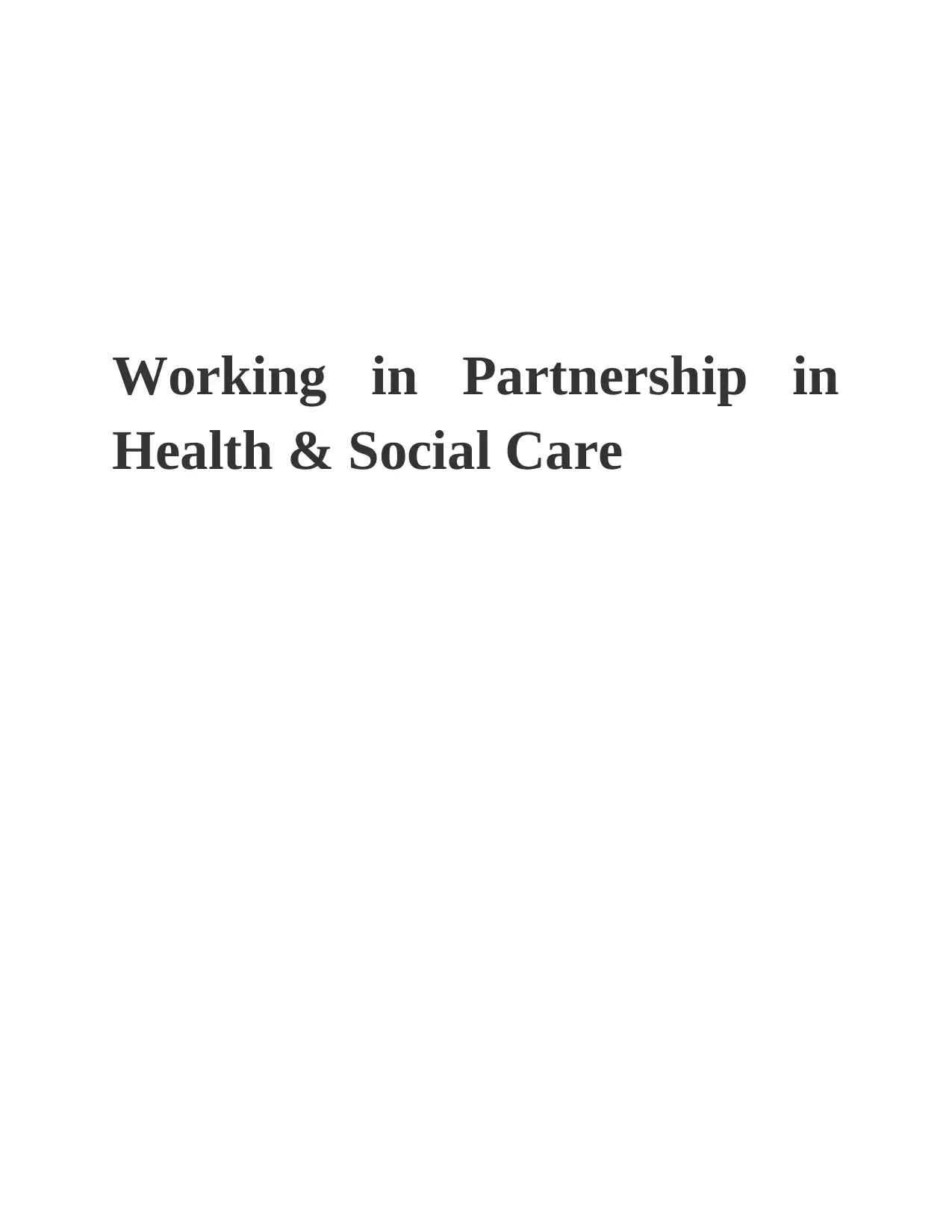
Working in Partnership in
Health & Social Care
Health & Social Care
Paraphrase This Document
Need a fresh take? Get an instant paraphrase of this document with our AI Paraphraser
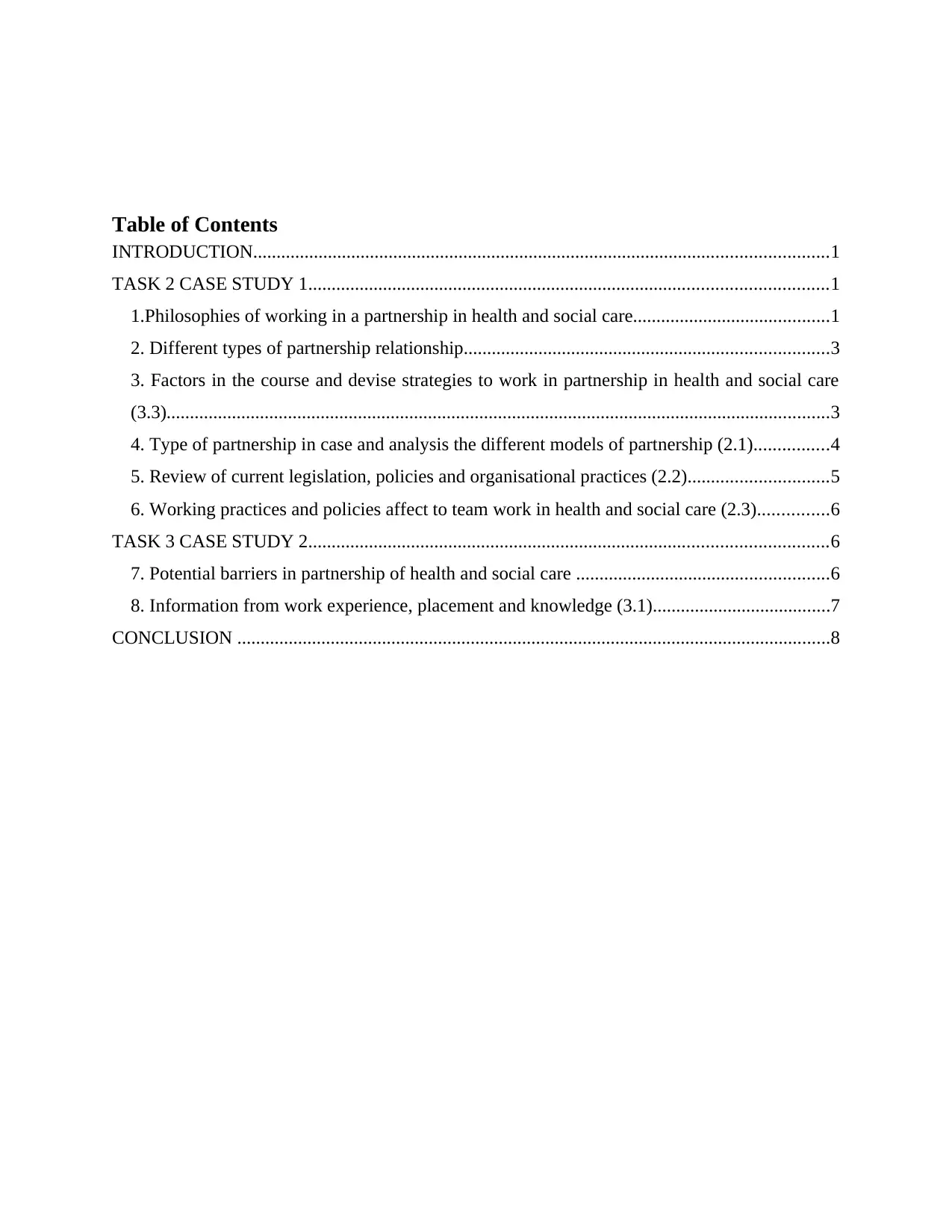
Table of Contents
INTRODUCTION...........................................................................................................................1
TASK 2 CASE STUDY 1...............................................................................................................1
1.Philosophies of working in a partnership in health and social care..........................................1
2. Different types of partnership relationship..............................................................................3
3. Factors in the course and devise strategies to work in partnership in health and social care
(3.3)..............................................................................................................................................3
4. Type of partnership in case and analysis the different models of partnership (2.1)................4
5. Review of current legislation, policies and organisational practices (2.2)..............................5
6. Working practices and policies affect to team work in health and social care (2.3)...............6
TASK 3 CASE STUDY 2...............................................................................................................6
7. Potential barriers in partnership of health and social care ......................................................6
8. Information from work experience, placement and knowledge (3.1)......................................7
CONCLUSION ...............................................................................................................................8
INTRODUCTION...........................................................................................................................1
TASK 2 CASE STUDY 1...............................................................................................................1
1.Philosophies of working in a partnership in health and social care..........................................1
2. Different types of partnership relationship..............................................................................3
3. Factors in the course and devise strategies to work in partnership in health and social care
(3.3)..............................................................................................................................................3
4. Type of partnership in case and analysis the different models of partnership (2.1)................4
5. Review of current legislation, policies and organisational practices (2.2)..............................5
6. Working practices and policies affect to team work in health and social care (2.3)...............6
TASK 3 CASE STUDY 2...............................................................................................................6
7. Potential barriers in partnership of health and social care ......................................................6
8. Information from work experience, placement and knowledge (3.1)......................................7
CONCLUSION ...............................................................................................................................8
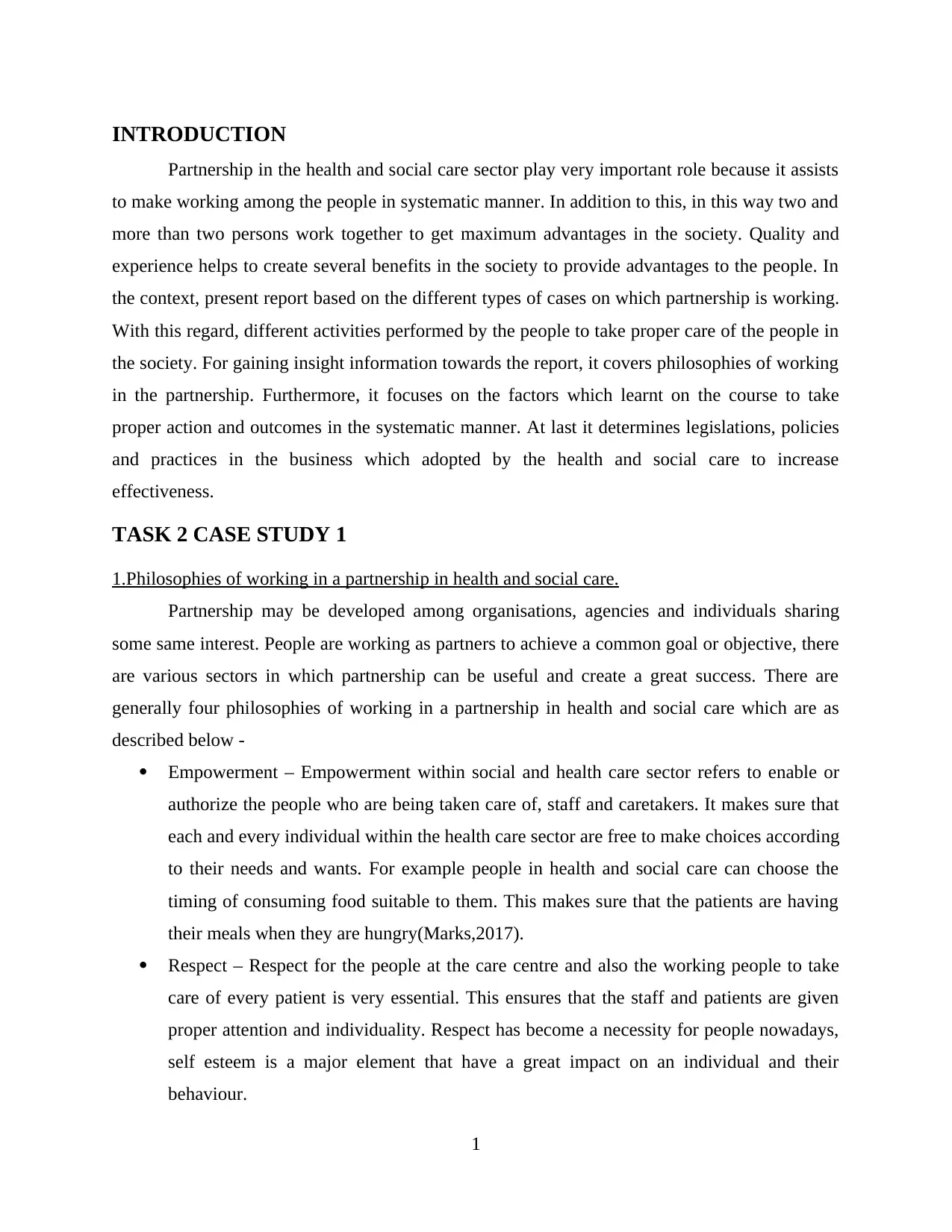
INTRODUCTION
Partnership in the health and social care sector play very important role because it assists
to make working among the people in systematic manner. In addition to this, in this way two and
more than two persons work together to get maximum advantages in the society. Quality and
experience helps to create several benefits in the society to provide advantages to the people. In
the context, present report based on the different types of cases on which partnership is working.
With this regard, different activities performed by the people to take proper care of the people in
the society. For gaining insight information towards the report, it covers philosophies of working
in the partnership. Furthermore, it focuses on the factors which learnt on the course to take
proper action and outcomes in the systematic manner. At last it determines legislations, policies
and practices in the business which adopted by the health and social care to increase
effectiveness.
TASK 2 CASE STUDY 1
1.Philosophies of working in a partnership in health and social care.
Partnership may be developed among organisations, agencies and individuals sharing
some same interest. People are working as partners to achieve a common goal or objective, there
are various sectors in which partnership can be useful and create a great success. There are
generally four philosophies of working in a partnership in health and social care which are as
described below -
Empowerment – Empowerment within social and health care sector refers to enable or
authorize the people who are being taken care of, staff and caretakers. It makes sure that
each and every individual within the health care sector are free to make choices according
to their needs and wants. For example people in health and social care can choose the
timing of consuming food suitable to them. This makes sure that the patients are having
their meals when they are hungry(Marks,2017).
Respect – Respect for the people at the care centre and also the working people to take
care of every patient is very essential. This ensures that the staff and patients are given
proper attention and individuality. Respect has become a necessity for people nowadays,
self esteem is a major element that have a great impact on an individual and their
behaviour.
1
Partnership in the health and social care sector play very important role because it assists
to make working among the people in systematic manner. In addition to this, in this way two and
more than two persons work together to get maximum advantages in the society. Quality and
experience helps to create several benefits in the society to provide advantages to the people. In
the context, present report based on the different types of cases on which partnership is working.
With this regard, different activities performed by the people to take proper care of the people in
the society. For gaining insight information towards the report, it covers philosophies of working
in the partnership. Furthermore, it focuses on the factors which learnt on the course to take
proper action and outcomes in the systematic manner. At last it determines legislations, policies
and practices in the business which adopted by the health and social care to increase
effectiveness.
TASK 2 CASE STUDY 1
1.Philosophies of working in a partnership in health and social care.
Partnership may be developed among organisations, agencies and individuals sharing
some same interest. People are working as partners to achieve a common goal or objective, there
are various sectors in which partnership can be useful and create a great success. There are
generally four philosophies of working in a partnership in health and social care which are as
described below -
Empowerment – Empowerment within social and health care sector refers to enable or
authorize the people who are being taken care of, staff and caretakers. It makes sure that
each and every individual within the health care sector are free to make choices according
to their needs and wants. For example people in health and social care can choose the
timing of consuming food suitable to them. This makes sure that the patients are having
their meals when they are hungry(Marks,2017).
Respect – Respect for the people at the care centre and also the working people to take
care of every patient is very essential. This ensures that the staff and patients are given
proper attention and individuality. Respect has become a necessity for people nowadays,
self esteem is a major element that have a great impact on an individual and their
behaviour.
1
⊘ This is a preview!⊘
Do you want full access?
Subscribe today to unlock all pages.

Trusted by 1+ million students worldwide
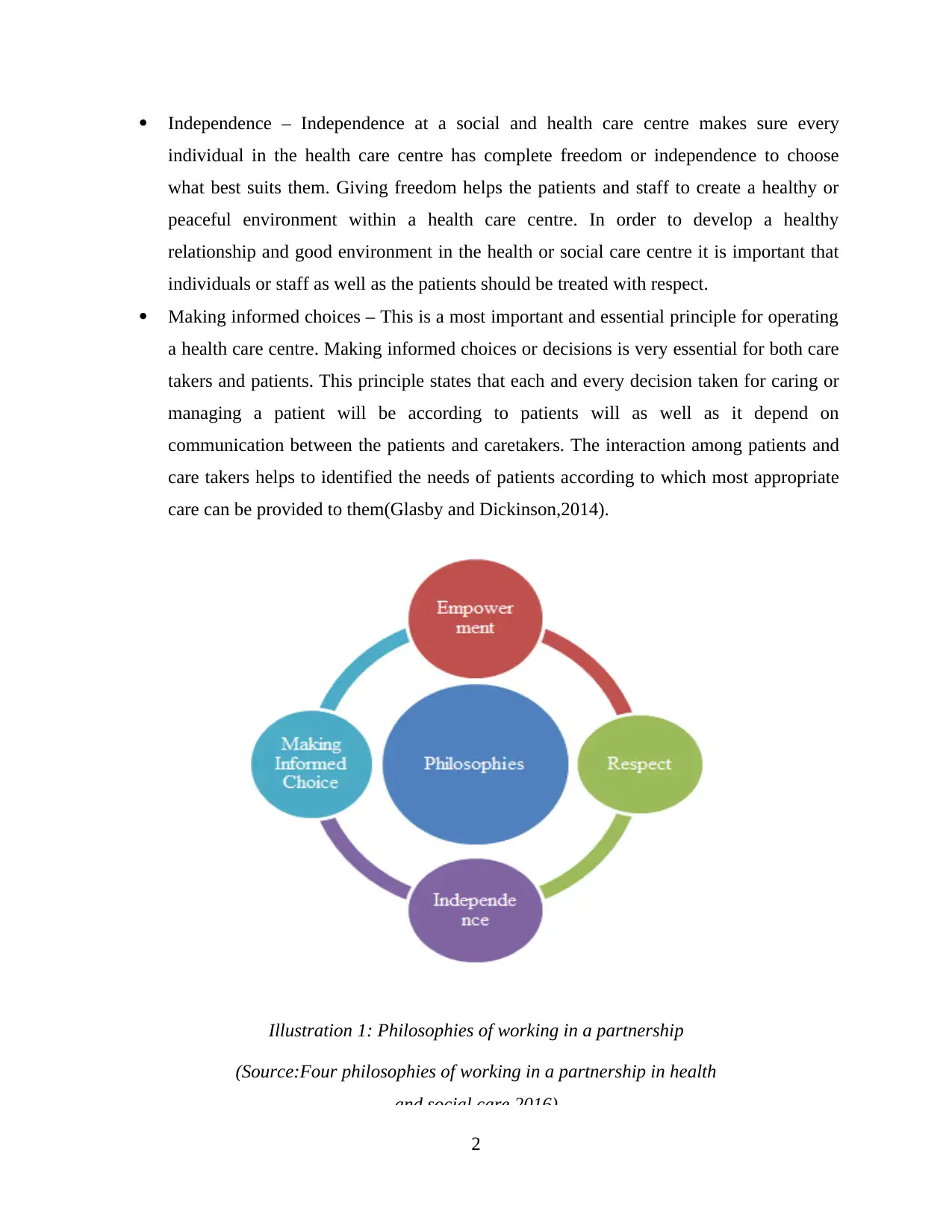
Independence – Independence at a social and health care centre makes sure every
individual in the health care centre has complete freedom or independence to choose
what best suits them. Giving freedom helps the patients and staff to create a healthy or
peaceful environment within a health care centre. In order to develop a healthy
relationship and good environment in the health or social care centre it is important that
individuals or staff as well as the patients should be treated with respect.
Making informed choices – This is a most important and essential principle for operating
a health care centre. Making informed choices or decisions is very essential for both care
takers and patients. This principle states that each and every decision taken for caring or
managing a patient will be according to patients will as well as it depend on
communication between the patients and caretakers. The interaction among patients and
care takers helps to identified the needs of patients according to which most appropriate
care can be provided to them(Glasby and Dickinson,2014).
Illustration 1: Philosophies of working in a partnership
(Source:Four philosophies of working in a partnership in health
and social care,2016)
2
individual in the health care centre has complete freedom or independence to choose
what best suits them. Giving freedom helps the patients and staff to create a healthy or
peaceful environment within a health care centre. In order to develop a healthy
relationship and good environment in the health or social care centre it is important that
individuals or staff as well as the patients should be treated with respect.
Making informed choices – This is a most important and essential principle for operating
a health care centre. Making informed choices or decisions is very essential for both care
takers and patients. This principle states that each and every decision taken for caring or
managing a patient will be according to patients will as well as it depend on
communication between the patients and caretakers. The interaction among patients and
care takers helps to identified the needs of patients according to which most appropriate
care can be provided to them(Glasby and Dickinson,2014).
Illustration 1: Philosophies of working in a partnership
(Source:Four philosophies of working in a partnership in health
and social care,2016)
2
Paraphrase This Document
Need a fresh take? Get an instant paraphrase of this document with our AI Paraphraser
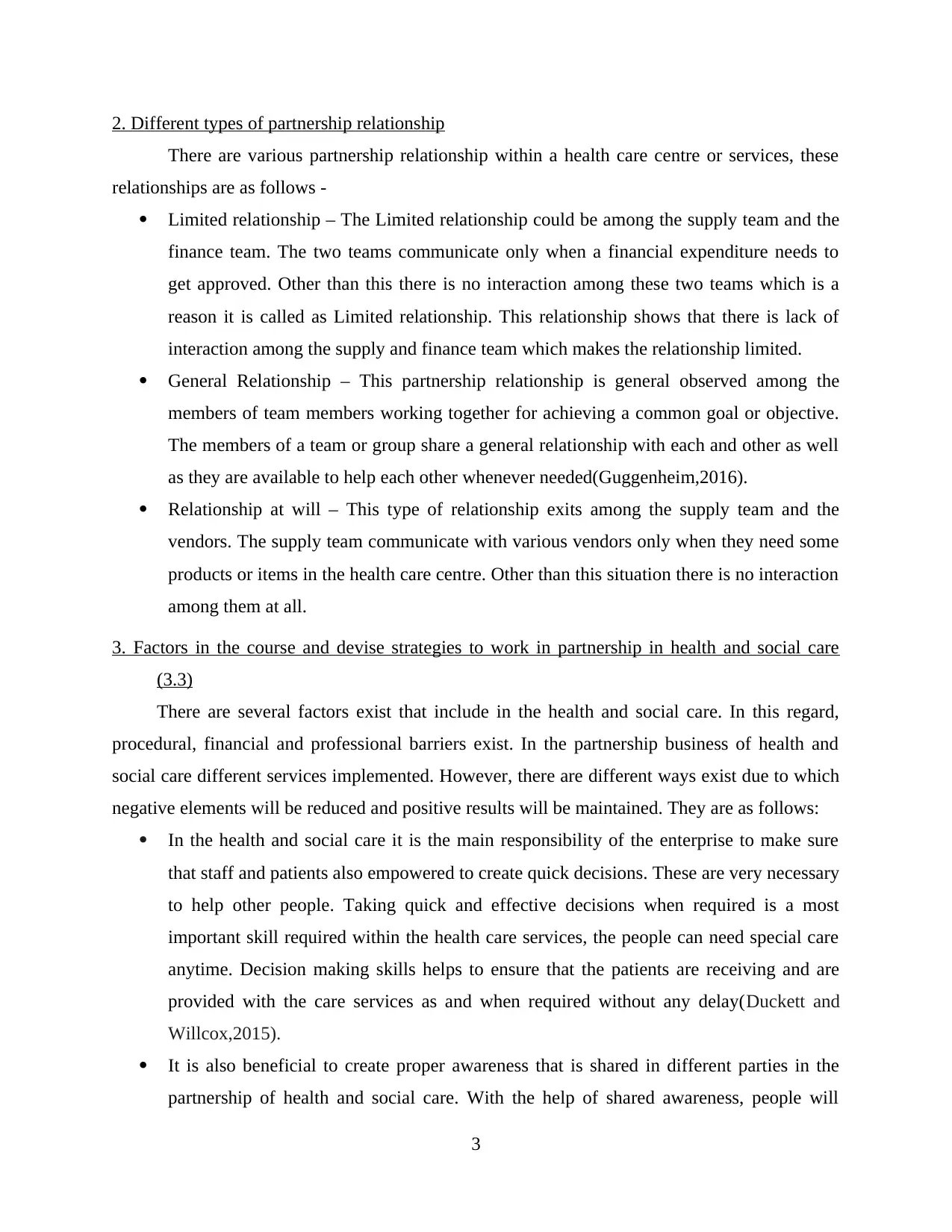
2. Different types of partnership relationship
There are various partnership relationship within a health care centre or services, these
relationships are as follows -
Limited relationship – The Limited relationship could be among the supply team and the
finance team. The two teams communicate only when a financial expenditure needs to
get approved. Other than this there is no interaction among these two teams which is a
reason it is called as Limited relationship. This relationship shows that there is lack of
interaction among the supply and finance team which makes the relationship limited.
General Relationship – This partnership relationship is general observed among the
members of team members working together for achieving a common goal or objective.
The members of a team or group share a general relationship with each and other as well
as they are available to help each other whenever needed(Guggenheim,2016).
Relationship at will – This type of relationship exits among the supply team and the
vendors. The supply team communicate with various vendors only when they need some
products or items in the health care centre. Other than this situation there is no interaction
among them at all.
3. Factors in the course and devise strategies to work in partnership in health and social care
(3.3)
There are several factors exist that include in the health and social care. In this regard,
procedural, financial and professional barriers exist. In the partnership business of health and
social care different services implemented. However, there are different ways exist due to which
negative elements will be reduced and positive results will be maintained. They are as follows:
In the health and social care it is the main responsibility of the enterprise to make sure
that staff and patients also empowered to create quick decisions. These are very necessary
to help other people. Taking quick and effective decisions when required is a most
important skill required within the health care services, the people can need special care
anytime. Decision making skills helps to ensure that the patients are receiving and are
provided with the care services as and when required without any delay(Duckett and
Willcox,2015).
It is also beneficial to create proper awareness that is shared in different parties in the
partnership of health and social care. With the help of shared awareness, people will
3
There are various partnership relationship within a health care centre or services, these
relationships are as follows -
Limited relationship – The Limited relationship could be among the supply team and the
finance team. The two teams communicate only when a financial expenditure needs to
get approved. Other than this there is no interaction among these two teams which is a
reason it is called as Limited relationship. This relationship shows that there is lack of
interaction among the supply and finance team which makes the relationship limited.
General Relationship – This partnership relationship is general observed among the
members of team members working together for achieving a common goal or objective.
The members of a team or group share a general relationship with each and other as well
as they are available to help each other whenever needed(Guggenheim,2016).
Relationship at will – This type of relationship exits among the supply team and the
vendors. The supply team communicate with various vendors only when they need some
products or items in the health care centre. Other than this situation there is no interaction
among them at all.
3. Factors in the course and devise strategies to work in partnership in health and social care
(3.3)
There are several factors exist that include in the health and social care. In this regard,
procedural, financial and professional barriers exist. In the partnership business of health and
social care different services implemented. However, there are different ways exist due to which
negative elements will be reduced and positive results will be maintained. They are as follows:
In the health and social care it is the main responsibility of the enterprise to make sure
that staff and patients also empowered to create quick decisions. These are very necessary
to help other people. Taking quick and effective decisions when required is a most
important skill required within the health care services, the people can need special care
anytime. Decision making skills helps to ensure that the patients are receiving and are
provided with the care services as and when required without any delay(Duckett and
Willcox,2015).
It is also beneficial to create proper awareness that is shared in different parties in the
partnership of health and social care. With the help of shared awareness, people will
3
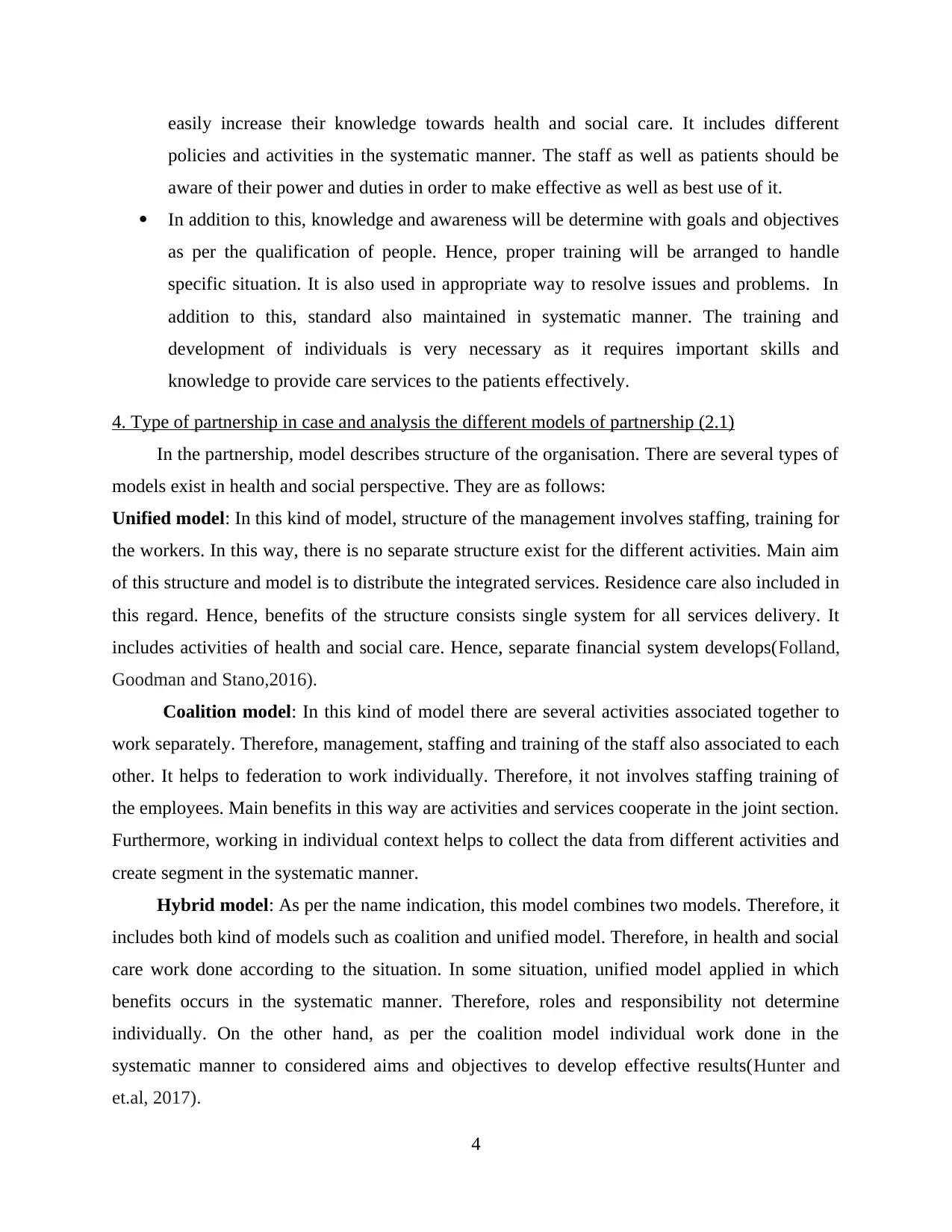
easily increase their knowledge towards health and social care. It includes different
policies and activities in the systematic manner. The staff as well as patients should be
aware of their power and duties in order to make effective as well as best use of it.
In addition to this, knowledge and awareness will be determine with goals and objectives
as per the qualification of people. Hence, proper training will be arranged to handle
specific situation. It is also used in appropriate way to resolve issues and problems. In
addition to this, standard also maintained in systematic manner. The training and
development of individuals is very necessary as it requires important skills and
knowledge to provide care services to the patients effectively.
4. Type of partnership in case and analysis the different models of partnership (2.1)
In the partnership, model describes structure of the organisation. There are several types of
models exist in health and social perspective. They are as follows:
Unified model: In this kind of model, structure of the management involves staffing, training for
the workers. In this way, there is no separate structure exist for the different activities. Main aim
of this structure and model is to distribute the integrated services. Residence care also included in
this regard. Hence, benefits of the structure consists single system for all services delivery. It
includes activities of health and social care. Hence, separate financial system develops(Folland,
Goodman and Stano,2016).
Coalition model: In this kind of model there are several activities associated together to
work separately. Therefore, management, staffing and training of the staff also associated to each
other. It helps to federation to work individually. Therefore, it not involves staffing training of
the employees. Main benefits in this way are activities and services cooperate in the joint section.
Furthermore, working in individual context helps to collect the data from different activities and
create segment in the systematic manner.
Hybrid model: As per the name indication, this model combines two models. Therefore, it
includes both kind of models such as coalition and unified model. Therefore, in health and social
care work done according to the situation. In some situation, unified model applied in which
benefits occurs in the systematic manner. Therefore, roles and responsibility not determine
individually. On the other hand, as per the coalition model individual work done in the
systematic manner to considered aims and objectives to develop effective results(Hunter and
et.al, 2017).
4
policies and activities in the systematic manner. The staff as well as patients should be
aware of their power and duties in order to make effective as well as best use of it.
In addition to this, knowledge and awareness will be determine with goals and objectives
as per the qualification of people. Hence, proper training will be arranged to handle
specific situation. It is also used in appropriate way to resolve issues and problems. In
addition to this, standard also maintained in systematic manner. The training and
development of individuals is very necessary as it requires important skills and
knowledge to provide care services to the patients effectively.
4. Type of partnership in case and analysis the different models of partnership (2.1)
In the partnership, model describes structure of the organisation. There are several types of
models exist in health and social perspective. They are as follows:
Unified model: In this kind of model, structure of the management involves staffing, training for
the workers. In this way, there is no separate structure exist for the different activities. Main aim
of this structure and model is to distribute the integrated services. Residence care also included in
this regard. Hence, benefits of the structure consists single system for all services delivery. It
includes activities of health and social care. Hence, separate financial system develops(Folland,
Goodman and Stano,2016).
Coalition model: In this kind of model there are several activities associated together to
work separately. Therefore, management, staffing and training of the staff also associated to each
other. It helps to federation to work individually. Therefore, it not involves staffing training of
the employees. Main benefits in this way are activities and services cooperate in the joint section.
Furthermore, working in individual context helps to collect the data from different activities and
create segment in the systematic manner.
Hybrid model: As per the name indication, this model combines two models. Therefore, it
includes both kind of models such as coalition and unified model. Therefore, in health and social
care work done according to the situation. In some situation, unified model applied in which
benefits occurs in the systematic manner. Therefore, roles and responsibility not determine
individually. On the other hand, as per the coalition model individual work done in the
systematic manner to considered aims and objectives to develop effective results(Hunter and
et.al, 2017).
4
⊘ This is a preview!⊘
Do you want full access?
Subscribe today to unlock all pages.

Trusted by 1+ million students worldwide
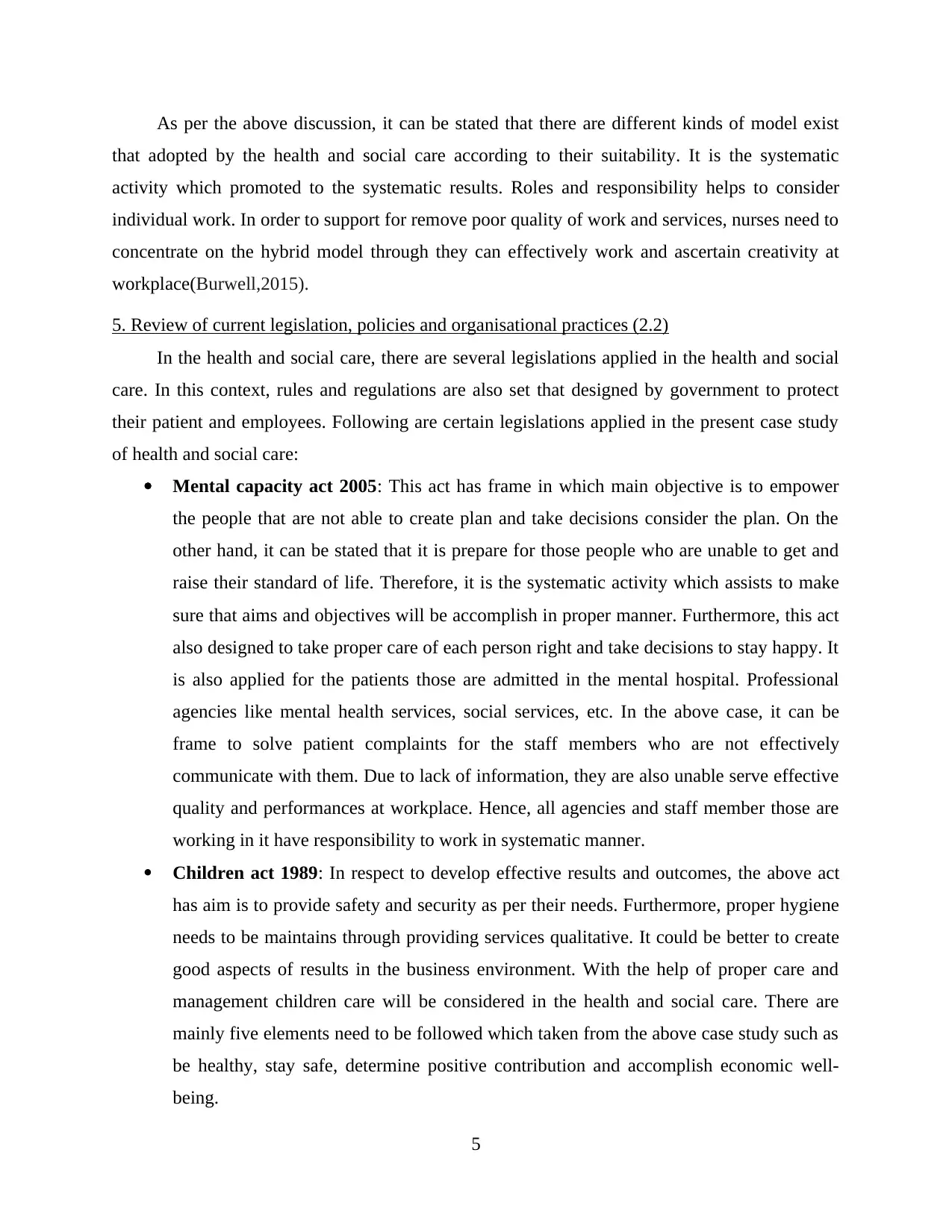
As per the above discussion, it can be stated that there are different kinds of model exist
that adopted by the health and social care according to their suitability. It is the systematic
activity which promoted to the systematic results. Roles and responsibility helps to consider
individual work. In order to support for remove poor quality of work and services, nurses need to
concentrate on the hybrid model through they can effectively work and ascertain creativity at
workplace(Burwell,2015).
5. Review of current legislation, policies and organisational practices (2.2)
In the health and social care, there are several legislations applied in the health and social
care. In this context, rules and regulations are also set that designed by government to protect
their patient and employees. Following are certain legislations applied in the present case study
of health and social care:
Mental capacity act 2005: This act has frame in which main objective is to empower
the people that are not able to create plan and take decisions consider the plan. On the
other hand, it can be stated that it is prepare for those people who are unable to get and
raise their standard of life. Therefore, it is the systematic activity which assists to make
sure that aims and objectives will be accomplish in proper manner. Furthermore, this act
also designed to take proper care of each person right and take decisions to stay happy. It
is also applied for the patients those are admitted in the mental hospital. Professional
agencies like mental health services, social services, etc. In the above case, it can be
frame to solve patient complaints for the staff members who are not effectively
communicate with them. Due to lack of information, they are also unable serve effective
quality and performances at workplace. Hence, all agencies and staff member those are
working in it have responsibility to work in systematic manner.
Children act 1989: In respect to develop effective results and outcomes, the above act
has aim is to provide safety and security as per their needs. Furthermore, proper hygiene
needs to be maintains through providing services qualitative. It could be better to create
good aspects of results in the business environment. With the help of proper care and
management children care will be considered in the health and social care. There are
mainly five elements need to be followed which taken from the above case study such as
be healthy, stay safe, determine positive contribution and accomplish economic well-
being.
5
that adopted by the health and social care according to their suitability. It is the systematic
activity which promoted to the systematic results. Roles and responsibility helps to consider
individual work. In order to support for remove poor quality of work and services, nurses need to
concentrate on the hybrid model through they can effectively work and ascertain creativity at
workplace(Burwell,2015).
5. Review of current legislation, policies and organisational practices (2.2)
In the health and social care, there are several legislations applied in the health and social
care. In this context, rules and regulations are also set that designed by government to protect
their patient and employees. Following are certain legislations applied in the present case study
of health and social care:
Mental capacity act 2005: This act has frame in which main objective is to empower
the people that are not able to create plan and take decisions consider the plan. On the
other hand, it can be stated that it is prepare for those people who are unable to get and
raise their standard of life. Therefore, it is the systematic activity which assists to make
sure that aims and objectives will be accomplish in proper manner. Furthermore, this act
also designed to take proper care of each person right and take decisions to stay happy. It
is also applied for the patients those are admitted in the mental hospital. Professional
agencies like mental health services, social services, etc. In the above case, it can be
frame to solve patient complaints for the staff members who are not effectively
communicate with them. Due to lack of information, they are also unable serve effective
quality and performances at workplace. Hence, all agencies and staff member those are
working in it have responsibility to work in systematic manner.
Children act 1989: In respect to develop effective results and outcomes, the above act
has aim is to provide safety and security as per their needs. Furthermore, proper hygiene
needs to be maintains through providing services qualitative. It could be better to create
good aspects of results in the business environment. With the help of proper care and
management children care will be considered in the health and social care. There are
mainly five elements need to be followed which taken from the above case study such as
be healthy, stay safe, determine positive contribution and accomplish economic well-
being.
5
Paraphrase This Document
Need a fresh take? Get an instant paraphrase of this document with our AI Paraphraser
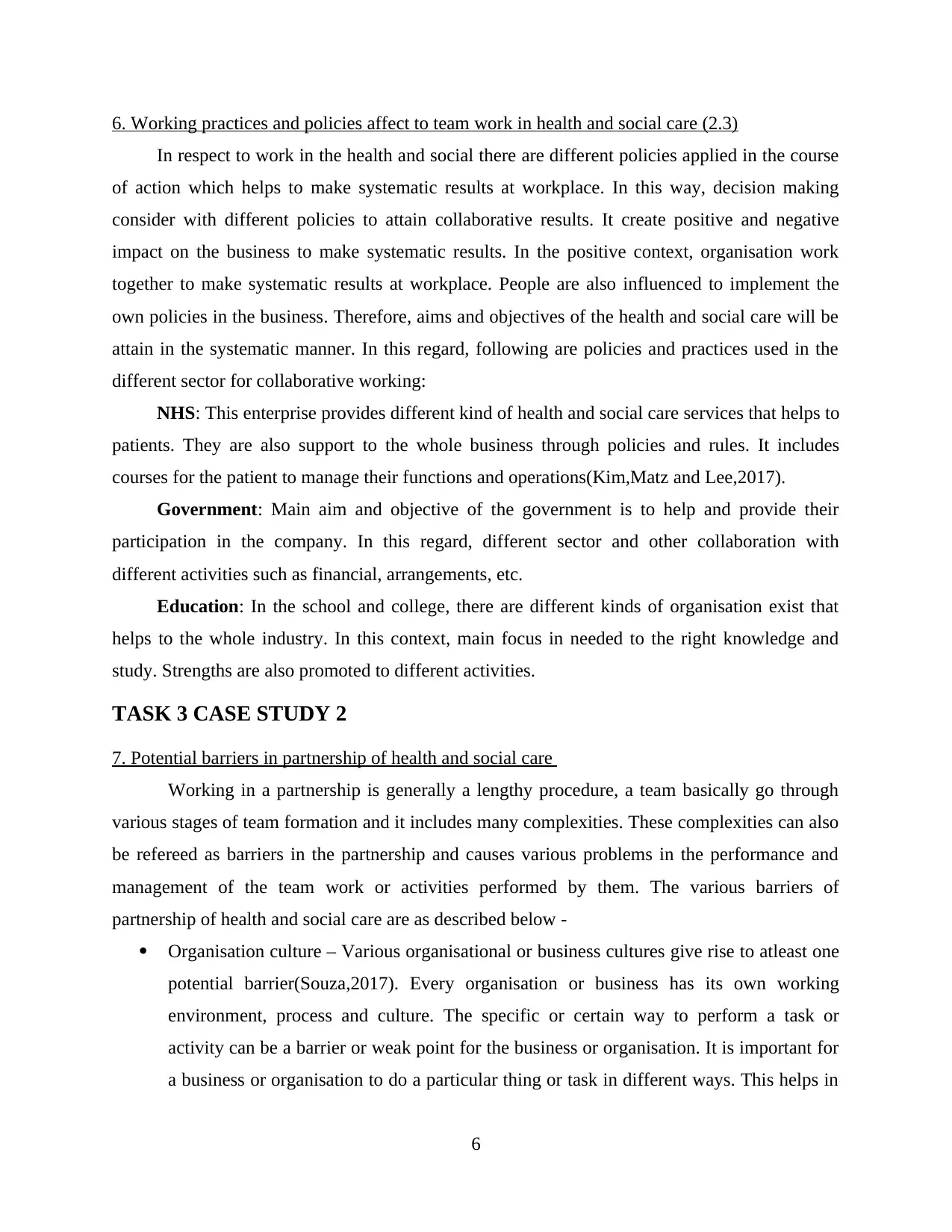
6. Working practices and policies affect to team work in health and social care (2.3)
In respect to work in the health and social there are different policies applied in the course
of action which helps to make systematic results at workplace. In this way, decision making
consider with different policies to attain collaborative results. It create positive and negative
impact on the business to make systematic results. In the positive context, organisation work
together to make systematic results at workplace. People are also influenced to implement the
own policies in the business. Therefore, aims and objectives of the health and social care will be
attain in the systematic manner. In this regard, following are policies and practices used in the
different sector for collaborative working:
NHS: This enterprise provides different kind of health and social care services that helps to
patients. They are also support to the whole business through policies and rules. It includes
courses for the patient to manage their functions and operations(Kim,Matz and Lee,2017).
Government: Main aim and objective of the government is to help and provide their
participation in the company. In this regard, different sector and other collaboration with
different activities such as financial, arrangements, etc.
Education: In the school and college, there are different kinds of organisation exist that
helps to the whole industry. In this context, main focus in needed to the right knowledge and
study. Strengths are also promoted to different activities.
TASK 3 CASE STUDY 2
7. Potential barriers in partnership of health and social care
Working in a partnership is generally a lengthy procedure, a team basically go through
various stages of team formation and it includes many complexities. These complexities can also
be refereed as barriers in the partnership and causes various problems in the performance and
management of the team work or activities performed by them. The various barriers of
partnership of health and social care are as described below -
Organisation culture – Various organisational or business cultures give rise to atleast one
potential barrier(Souza,2017). Every organisation or business has its own working
environment, process and culture. The specific or certain way to perform a task or
activity can be a barrier or weak point for the business or organisation. It is important for
a business or organisation to do a particular thing or task in different ways. This helps in
6
In respect to work in the health and social there are different policies applied in the course
of action which helps to make systematic results at workplace. In this way, decision making
consider with different policies to attain collaborative results. It create positive and negative
impact on the business to make systematic results. In the positive context, organisation work
together to make systematic results at workplace. People are also influenced to implement the
own policies in the business. Therefore, aims and objectives of the health and social care will be
attain in the systematic manner. In this regard, following are policies and practices used in the
different sector for collaborative working:
NHS: This enterprise provides different kind of health and social care services that helps to
patients. They are also support to the whole business through policies and rules. It includes
courses for the patient to manage their functions and operations(Kim,Matz and Lee,2017).
Government: Main aim and objective of the government is to help and provide their
participation in the company. In this regard, different sector and other collaboration with
different activities such as financial, arrangements, etc.
Education: In the school and college, there are different kinds of organisation exist that
helps to the whole industry. In this context, main focus in needed to the right knowledge and
study. Strengths are also promoted to different activities.
TASK 3 CASE STUDY 2
7. Potential barriers in partnership of health and social care
Working in a partnership is generally a lengthy procedure, a team basically go through
various stages of team formation and it includes many complexities. These complexities can also
be refereed as barriers in the partnership and causes various problems in the performance and
management of the team work or activities performed by them. The various barriers of
partnership of health and social care are as described below -
Organisation culture – Various organisational or business cultures give rise to atleast one
potential barrier(Souza,2017). Every organisation or business has its own working
environment, process and culture. The specific or certain way to perform a task or
activity can be a barrier or weak point for the business or organisation. It is important for
a business or organisation to do a particular thing or task in different ways. This helps in
6
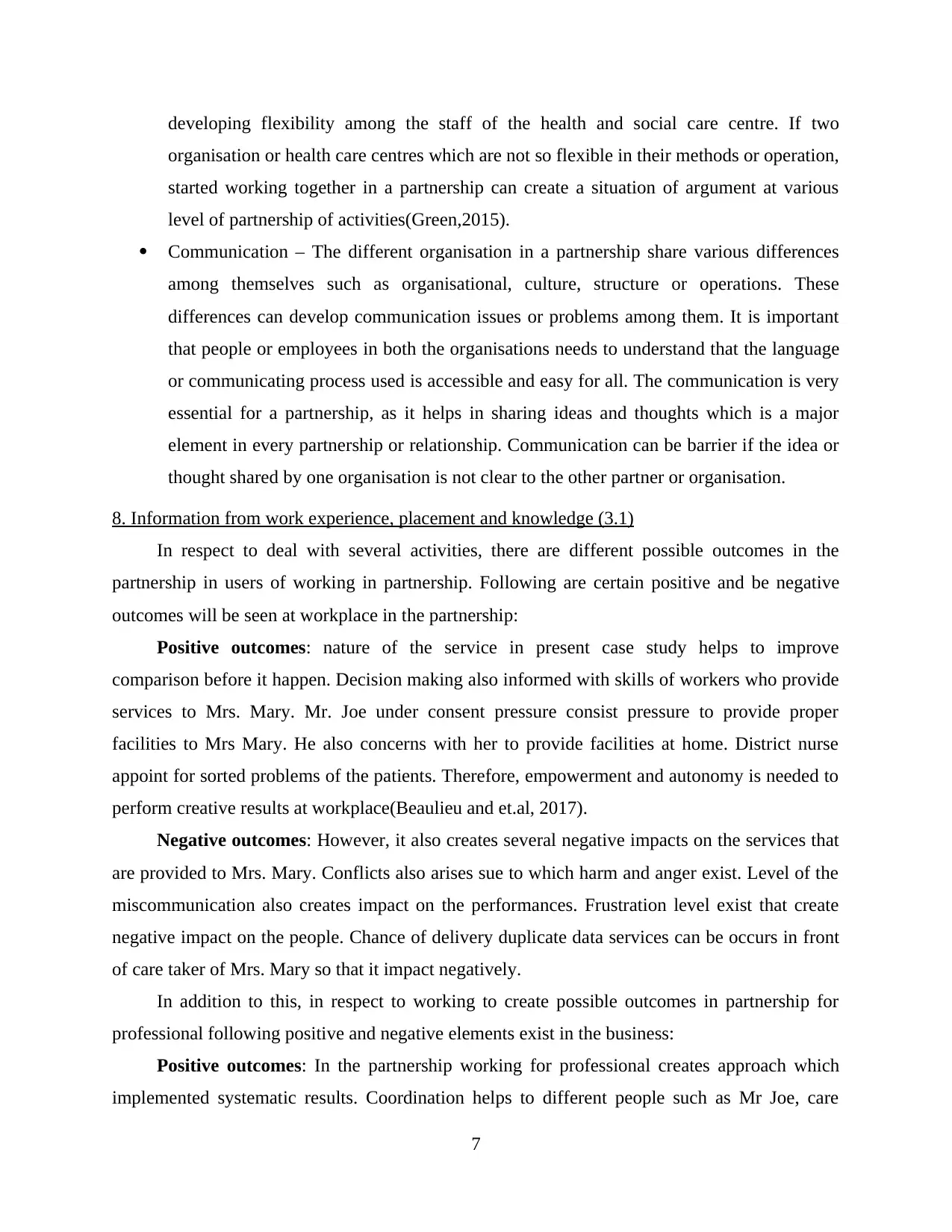
developing flexibility among the staff of the health and social care centre. If two
organisation or health care centres which are not so flexible in their methods or operation,
started working together in a partnership can create a situation of argument at various
level of partnership of activities(Green,2015).
Communication – The different organisation in a partnership share various differences
among themselves such as organisational, culture, structure or operations. These
differences can develop communication issues or problems among them. It is important
that people or employees in both the organisations needs to understand that the language
or communicating process used is accessible and easy for all. The communication is very
essential for a partnership, as it helps in sharing ideas and thoughts which is a major
element in every partnership or relationship. Communication can be barrier if the idea or
thought shared by one organisation is not clear to the other partner or organisation.
8. Information from work experience, placement and knowledge (3.1)
In respect to deal with several activities, there are different possible outcomes in the
partnership in users of working in partnership. Following are certain positive and be negative
outcomes will be seen at workplace in the partnership:
Positive outcomes: nature of the service in present case study helps to improve
comparison before it happen. Decision making also informed with skills of workers who provide
services to Mrs. Mary. Mr. Joe under consent pressure consist pressure to provide proper
facilities to Mrs Mary. He also concerns with her to provide facilities at home. District nurse
appoint for sorted problems of the patients. Therefore, empowerment and autonomy is needed to
perform creative results at workplace(Beaulieu and et.al, 2017).
Negative outcomes: However, it also creates several negative impacts on the services that
are provided to Mrs. Mary. Conflicts also arises sue to which harm and anger exist. Level of the
miscommunication also creates impact on the performances. Frustration level exist that create
negative impact on the people. Chance of delivery duplicate data services can be occurs in front
of care taker of Mrs. Mary so that it impact negatively.
In addition to this, in respect to working to create possible outcomes in partnership for
professional following positive and negative elements exist in the business:
Positive outcomes: In the partnership working for professional creates approach which
implemented systematic results. Coordination helps to different people such as Mr Joe, care
7
organisation or health care centres which are not so flexible in their methods or operation,
started working together in a partnership can create a situation of argument at various
level of partnership of activities(Green,2015).
Communication – The different organisation in a partnership share various differences
among themselves such as organisational, culture, structure or operations. These
differences can develop communication issues or problems among them. It is important
that people or employees in both the organisations needs to understand that the language
or communicating process used is accessible and easy for all. The communication is very
essential for a partnership, as it helps in sharing ideas and thoughts which is a major
element in every partnership or relationship. Communication can be barrier if the idea or
thought shared by one organisation is not clear to the other partner or organisation.
8. Information from work experience, placement and knowledge (3.1)
In respect to deal with several activities, there are different possible outcomes in the
partnership in users of working in partnership. Following are certain positive and be negative
outcomes will be seen at workplace in the partnership:
Positive outcomes: nature of the service in present case study helps to improve
comparison before it happen. Decision making also informed with skills of workers who provide
services to Mrs. Mary. Mr. Joe under consent pressure consist pressure to provide proper
facilities to Mrs Mary. He also concerns with her to provide facilities at home. District nurse
appoint for sorted problems of the patients. Therefore, empowerment and autonomy is needed to
perform creative results at workplace(Beaulieu and et.al, 2017).
Negative outcomes: However, it also creates several negative impacts on the services that
are provided to Mrs. Mary. Conflicts also arises sue to which harm and anger exist. Level of the
miscommunication also creates impact on the performances. Frustration level exist that create
negative impact on the people. Chance of delivery duplicate data services can be occurs in front
of care taker of Mrs. Mary so that it impact negatively.
In addition to this, in respect to working to create possible outcomes in partnership for
professional following positive and negative elements exist in the business:
Positive outcomes: In the partnership working for professional creates approach which
implemented systematic results. Coordination helps to different people such as Mr Joe, care
7
⊘ This is a preview!⊘
Do you want full access?
Subscribe today to unlock all pages.

Trusted by 1+ million students worldwide
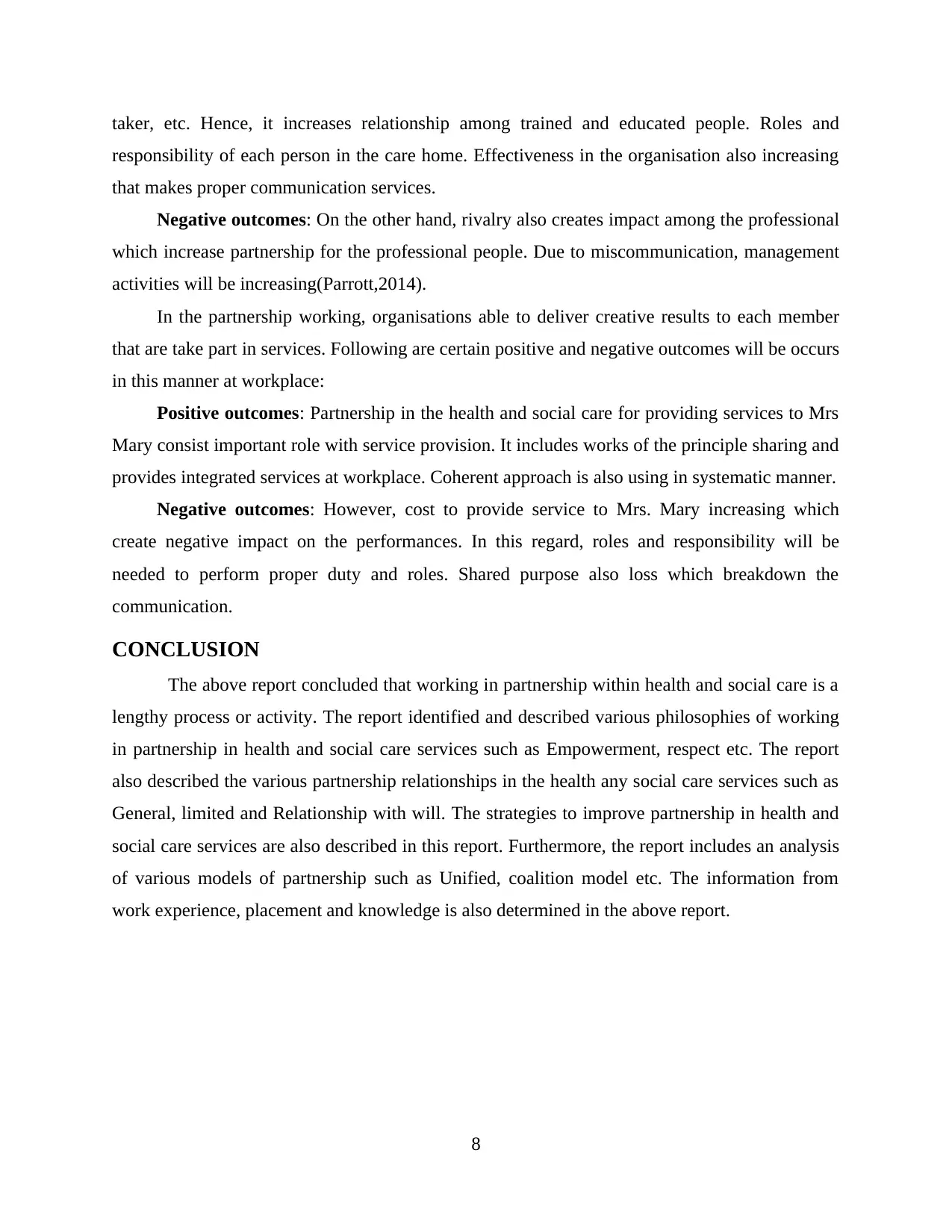
taker, etc. Hence, it increases relationship among trained and educated people. Roles and
responsibility of each person in the care home. Effectiveness in the organisation also increasing
that makes proper communication services.
Negative outcomes: On the other hand, rivalry also creates impact among the professional
which increase partnership for the professional people. Due to miscommunication, management
activities will be increasing(Parrott,2014).
In the partnership working, organisations able to deliver creative results to each member
that are take part in services. Following are certain positive and negative outcomes will be occurs
in this manner at workplace:
Positive outcomes: Partnership in the health and social care for providing services to Mrs
Mary consist important role with service provision. It includes works of the principle sharing and
provides integrated services at workplace. Coherent approach is also using in systematic manner.
Negative outcomes: However, cost to provide service to Mrs. Mary increasing which
create negative impact on the performances. In this regard, roles and responsibility will be
needed to perform proper duty and roles. Shared purpose also loss which breakdown the
communication.
CONCLUSION
The above report concluded that working in partnership within health and social care is a
lengthy process or activity. The report identified and described various philosophies of working
in partnership in health and social care services such as Empowerment, respect etc. The report
also described the various partnership relationships in the health any social care services such as
General, limited and Relationship with will. The strategies to improve partnership in health and
social care services are also described in this report. Furthermore, the report includes an analysis
of various models of partnership such as Unified, coalition model etc. The information from
work experience, placement and knowledge is also determined in the above report.
8
responsibility of each person in the care home. Effectiveness in the organisation also increasing
that makes proper communication services.
Negative outcomes: On the other hand, rivalry also creates impact among the professional
which increase partnership for the professional people. Due to miscommunication, management
activities will be increasing(Parrott,2014).
In the partnership working, organisations able to deliver creative results to each member
that are take part in services. Following are certain positive and negative outcomes will be occurs
in this manner at workplace:
Positive outcomes: Partnership in the health and social care for providing services to Mrs
Mary consist important role with service provision. It includes works of the principle sharing and
provides integrated services at workplace. Coherent approach is also using in systematic manner.
Negative outcomes: However, cost to provide service to Mrs. Mary increasing which
create negative impact on the performances. In this regard, roles and responsibility will be
needed to perform proper duty and roles. Shared purpose also loss which breakdown the
communication.
CONCLUSION
The above report concluded that working in partnership within health and social care is a
lengthy process or activity. The report identified and described various philosophies of working
in partnership in health and social care services such as Empowerment, respect etc. The report
also described the various partnership relationships in the health any social care services such as
General, limited and Relationship with will. The strategies to improve partnership in health and
social care services are also described in this report. Furthermore, the report includes an analysis
of various models of partnership such as Unified, coalition model etc. The information from
work experience, placement and knowledge is also determined in the above report.
8
Paraphrase This Document
Need a fresh take? Get an instant paraphrase of this document with our AI Paraphraser
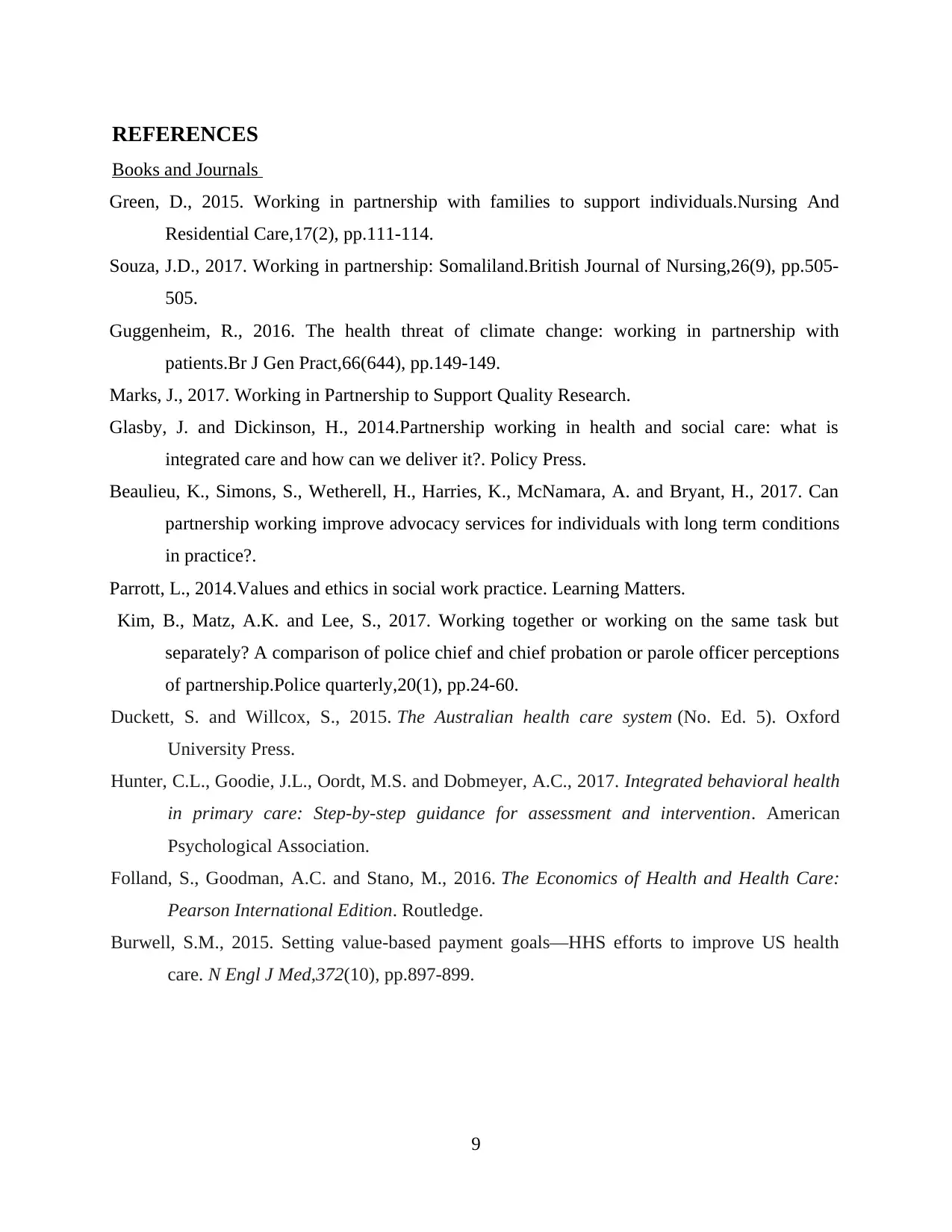
REFERENCES
Books and Journals
Green, D., 2015. Working in partnership with families to support individuals.Nursing And
Residential Care,17(2), pp.111-114.
Souza, J.D., 2017. Working in partnership: Somaliland.British Journal of Nursing,26(9), pp.505-
505.
Guggenheim, R., 2016. The health threat of climate change: working in partnership with
patients.Br J Gen Pract,66(644), pp.149-149.
Marks, J., 2017. Working in Partnership to Support Quality Research.
Glasby, J. and Dickinson, H., 2014.Partnership working in health and social care: what is
integrated care and how can we deliver it?. Policy Press.
Beaulieu, K., Simons, S., Wetherell, H., Harries, K., McNamara, A. and Bryant, H., 2017. Can
partnership working improve advocacy services for individuals with long term conditions
in practice?.
Parrott, L., 2014.Values and ethics in social work practice. Learning Matters.
Kim, B., Matz, A.K. and Lee, S., 2017. Working together or working on the same task but
separately? A comparison of police chief and chief probation or parole officer perceptions
of partnership.Police quarterly,20(1), pp.24-60.
Duckett, S. and Willcox, S., 2015. The Australian health care system (No. Ed. 5). Oxford
University Press.
Hunter, C.L., Goodie, J.L., Oordt, M.S. and Dobmeyer, A.C., 2017. Integrated behavioral health
in primary care: Step-by-step guidance for assessment and intervention. American
Psychological Association.
Folland, S., Goodman, A.C. and Stano, M., 2016. The Economics of Health and Health Care:
Pearson International Edition. Routledge.
Burwell, S.M., 2015. Setting value-based payment goals—HHS efforts to improve US health
care. N Engl J Med,372(10), pp.897-899.
9
Books and Journals
Green, D., 2015. Working in partnership with families to support individuals.Nursing And
Residential Care,17(2), pp.111-114.
Souza, J.D., 2017. Working in partnership: Somaliland.British Journal of Nursing,26(9), pp.505-
505.
Guggenheim, R., 2016. The health threat of climate change: working in partnership with
patients.Br J Gen Pract,66(644), pp.149-149.
Marks, J., 2017. Working in Partnership to Support Quality Research.
Glasby, J. and Dickinson, H., 2014.Partnership working in health and social care: what is
integrated care and how can we deliver it?. Policy Press.
Beaulieu, K., Simons, S., Wetherell, H., Harries, K., McNamara, A. and Bryant, H., 2017. Can
partnership working improve advocacy services for individuals with long term conditions
in practice?.
Parrott, L., 2014.Values and ethics in social work practice. Learning Matters.
Kim, B., Matz, A.K. and Lee, S., 2017. Working together or working on the same task but
separately? A comparison of police chief and chief probation or parole officer perceptions
of partnership.Police quarterly,20(1), pp.24-60.
Duckett, S. and Willcox, S., 2015. The Australian health care system (No. Ed. 5). Oxford
University Press.
Hunter, C.L., Goodie, J.L., Oordt, M.S. and Dobmeyer, A.C., 2017. Integrated behavioral health
in primary care: Step-by-step guidance for assessment and intervention. American
Psychological Association.
Folland, S., Goodman, A.C. and Stano, M., 2016. The Economics of Health and Health Care:
Pearson International Edition. Routledge.
Burwell, S.M., 2015. Setting value-based payment goals—HHS efforts to improve US health
care. N Engl J Med,372(10), pp.897-899.
9
1 out of 11
Related Documents
Your All-in-One AI-Powered Toolkit for Academic Success.
+13062052269
info@desklib.com
Available 24*7 on WhatsApp / Email
![[object Object]](/_next/static/media/star-bottom.7253800d.svg)
Unlock your academic potential
Copyright © 2020–2025 A2Z Services. All Rights Reserved. Developed and managed by ZUCOL.





